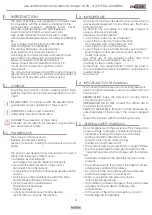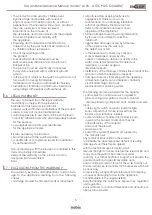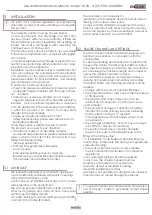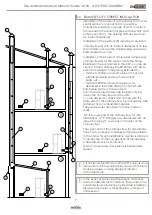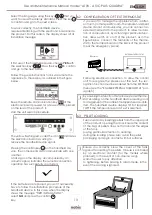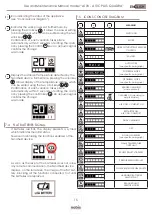
Use and Maintenance Manual model “A10V - A10C PLUS QUADRA”
6
ENGLISH
1.8 SPARE PARTS
Only use original spare parts.
Do not wait for the components to wear from use be-
fore replacing them.
This measure promotes prevention of accidents
caused by people, animals or property in the event
of product malfunctioning caused by faults.
You are advised to contact authorised staff to re-
place spare parts, worn parts and for extraordinary
maintenance of the the product.
1.9 IDENTIFICATION PLATE
The plate placed on the back of the product outlines
all the characteristic data of the appliance, includ-
ing the manufacturer's data, the serial number and
the CE marking.
1.10 PRODUCT DISPOSAL
Demolition and disposal of the product is the exclu-
sive responsibility of the owner, who should do so in
compliance with legislation in force in his
country on safety matters, with respect of and safe-
guarding the environment.
At the end of its useful life, the product must not be
disposed of as urban waste.
It can be delivered to specific differentiated waste
collection centres made available by municipal ad-
ministrations, or dealers who provide this service.
Disposal of the product as differentiated waste
means possible negative consequences for the envi-
ronment and health are avoided, deriving from
inadequate disposal. Furthermore, it allows
recovery of materials composing the product to
obtain important savings in energy and
resources.
1.11 HERMETIC PRODUCT
The products manufactured with a perfectly hermet-
ic
structure do not consume oxygen in the environ-
ment, since they take all the air from outside the
home (if correctly installed) and can therefore be
positioned inside all homes with a high level of insu-
lation, such as “passive houses” or “with high energy
efficiency”. Thanks to this technology, there is no risk
of smoke emissions in the environment and no venti-
lation grates are necessary.
As a result, no cold air flows are created in the en
-
vironment making it less comfortable and reducing
the overall efficiency of the system. Hermetic prod
-
ucts can also be installed in the presence of forced
ventilation or in premises which can go into negative
pressure compared to outside.
2
CHARACTERISTICS OF THE PELLETS
Wood pellets are fuel made of pressed sawdust, of-
ten recovered from carpentry processing waste. The
material used cannot contain any foreign substance
such as glue, varnish or synthetic substances.
Sawdust, after drying and cleaning of impurities, it
is pressed using a matrix: due to the high pressure,
the sawdust heats activating the natural binders in
the wood; by doing so, the pellet maintains its shape
even without adding artificial substances. The density
of wood pellets varies based on the type of wood
and can exceed 1.5 - 2 times that of natural wood.
The cylinders have a diameter of 6mm and a
variable length of 10 to 40mm.
Their density is equal to approx. 650 kg/m3. Due to
the low water content (< 10%), they have a high en-
ergy content.
The main quality certifications for pellets on the Euro
-
pean market today guarantee the fuel is within
class A1 in according to ISO 17225-2:2014 (formerly
EN 14961). Examples of these certifications are for ex
-
ample ENPlus, DINplus, Ö-Norm M7135, and guaran-
tee they comply in particular with the following char-
acteristics:
• heating power: 4.6 ÷ 5.3 kWh/kg;
• water content: ≤ 10% of weight;
• percentage of ash: max 1.2% of weight
(A1 under 0.7%);
• diameter: 6±1/8±1 mm;
• length: 3÷40 mm;
• content: 100% untreated wood without
any additional binder substances (percentage of
bark max 5%);
• packaging: in sacks made from
eco-compatible or
bio-degradable.
The manufacturer recommends, for its products, use of
class A1 certified fuel according to the standard En ISO
17225-2:2014, or certified DIN
PLUS (more restrictive than class A1) or O-NORM M7135.
Pellets must be kept in a dry environment which is not
excessively cold. You are also advised to keep some
bags of pellets where the product is installed and op-
erating, to dry them of any humidity present.
Non-compliance with this aspect reduces the ther-
mal power of the fuel and means greater mainte-
nance must be done on the product.




